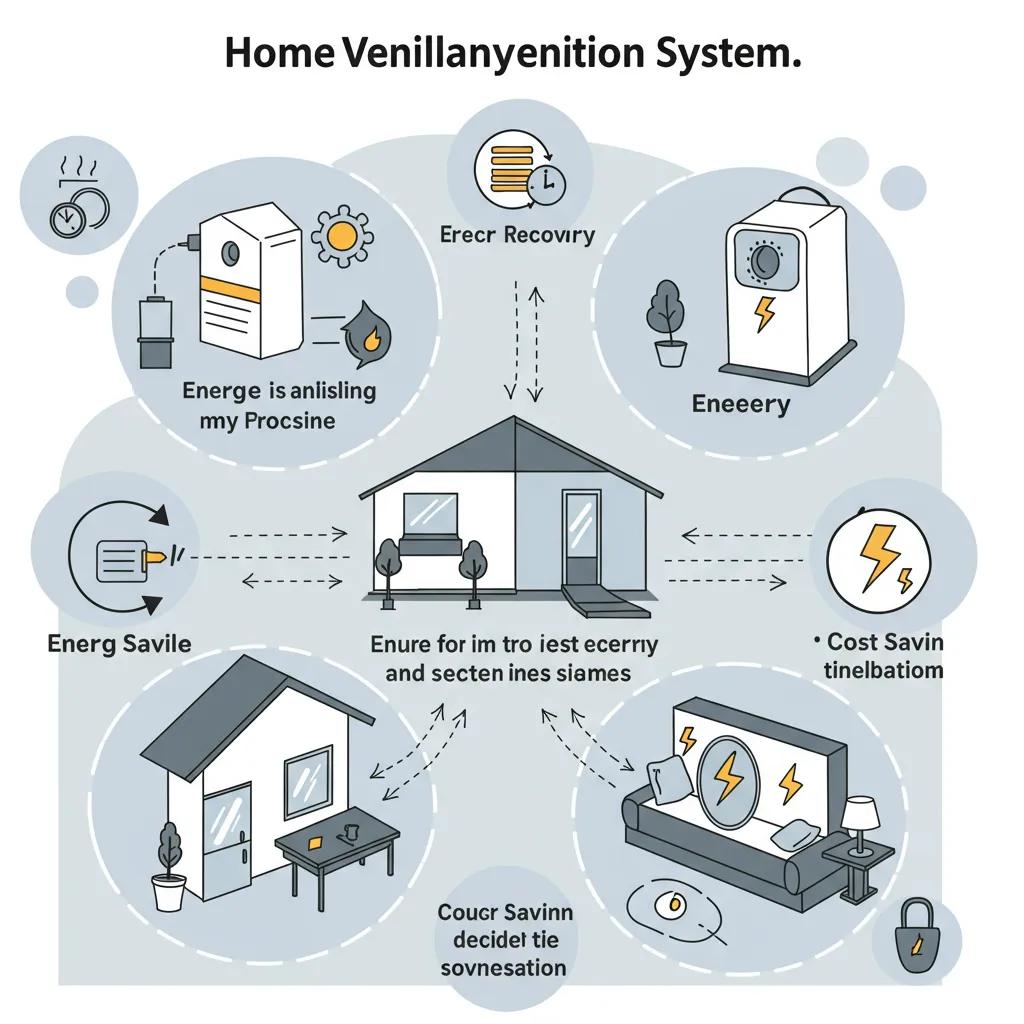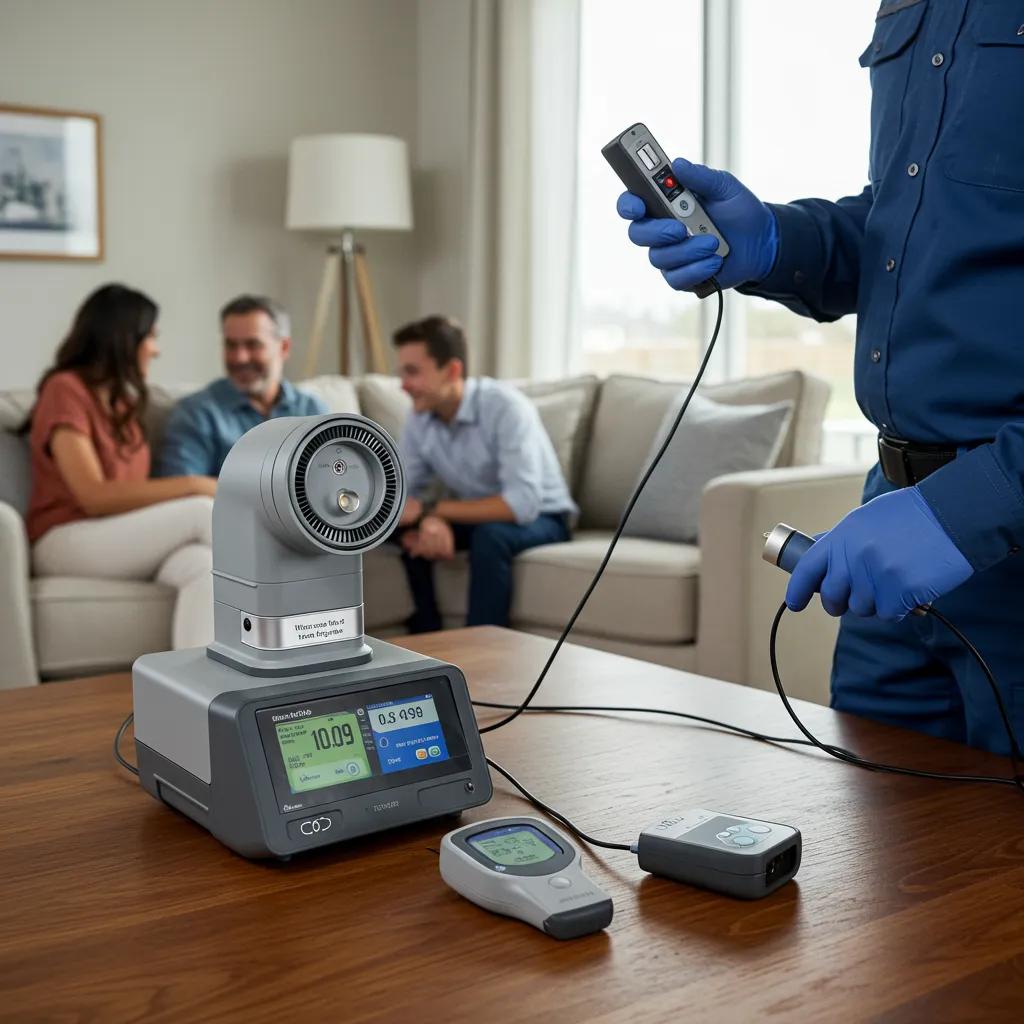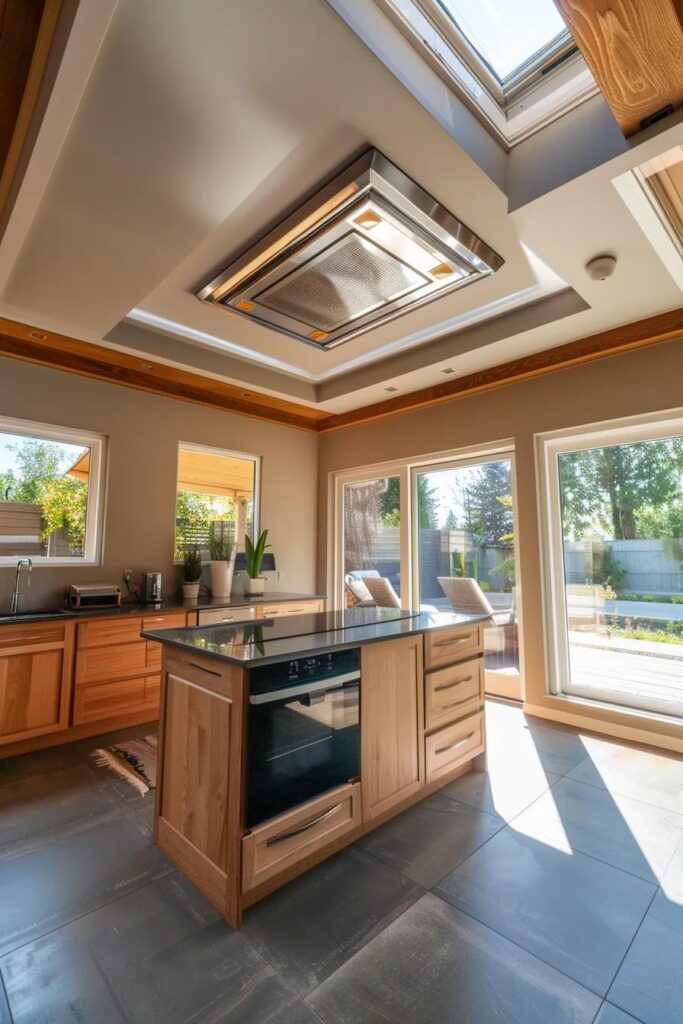Expert Home Ventilation System Installation & Indoor Air Quality Solutions in York, Lancaster, and Dauphin Counties
Transform your home’s air with advanced ventilation that ensures a constant supply of fresh, healthy air by expertly managing air exchange, humidity, and energy recovery. Beyond safeguarding your health from respiratory issues and moisture damage, a well-ventilated home offers superior comfort year-round and significantly cuts down on heating and cooling expenses. This comprehensive guide delves into: 1) the critical importance of ventilation for your well-being and comfort; 2) the various system types available, from MVHR and ERV to PIV and exhaust-only units; 3) Advance Haws’ complete approach to installation and ongoing care; 4) methods for testing your indoor air quality; 5) the vital role of professional duct cleaning; 6) the cost-effectiveness and energy savings of MVHR systems; and 7) specific considerations for Pennsylvania’s climate and building codes. By combining expert knowledge with local best practices, homeowners and property managers across York, Lancaster, and Dauphin Counties will gain the insights needed to enhance air circulation, prevent mould, optimize energy efficiency, and partner with Advance Haws for seamless system installation and support.
Why Is Enhancing Home Ventilation Crucial for Health and Comfort?
Improving your home’s ventilation involves installing systems that actively exchange indoor and outdoor air, precisely control humidity, and filter out pollutants, all contributing to a healthier and more comfortable living environment. Effective air exchange removes harmful compounds like volatile organic compounds and carbon dioxide, along with airborne allergens, thereby reducing irritation and fatigue. For instance, a balanced ventilation system with heat pumps maintains a steady flow of fresh air without compromising your home’s warmth, perfectly balancing health needs with energy efficiency.
How Does Inadequate Ventilation Impact Indoor Air Quality and Health?
When ventilation is poor, indoor pollutants such as carbon dioxide, volatile organic compounds, pet dander, and fine particles become trapped inside, directly increasing the likelihood of headaches, allergies, and asthma flare-ups. Insufficient air exchange can lead to persistent fatigue, sinus congestion, and elevated carbon dioxide levels that impair cognitive function. In tightly sealed homes, stagnant air becomes a breeding ground for allergens and microbes, negatively affecting overall well-being and productivity. Addressing this starts with selecting a ventilation system designed for continuous, filtered airflow and effective humidity regulation, which are key to preventing mould growth.
What Are the Advantages of Proper Ventilation for Preventing Mould and Condensation?
Effective ventilation actively manages moisture by replacing humid indoor air with drier outdoor air, thereby preventing condensation on windows and cool surfaces that fuels mould growth. Maintaining a relative humidity level between 40–60 percent through balanced ventilation systems actively inhibits mould spore proliferation and protects your home’s structure from moisture damage. For example, mechanical ventilation with heat recovery (MVHR) efficiently removes excess moisture from areas like kitchens and bathrooms before it can condense within wall cavities. By preventing damp conditions, homeowners can safeguard their indoor air quality, preserve interior finishes, and reduce allergy triggers and costly repairs.
How Does Ventilation Contribute to Energy Efficiency and Cost Savings?

Advanced ventilation systems don’t just replace stale air; they ingeniously recover heat from outgoing air to pre-warm incoming air, significantly reducing the demand on your heating and cooling systems. Mechanical and energy recovery ventilators can transfer up to 85 percent of thermal energy between air streams, leading to utility cost reductions of up to 30 percent during colder months and preventing excessive cooling in the summer. This recovered energy minimizes the runtime of your furnace and air conditioner, extending their lifespan and lowering maintenance expenses. By redirecting these energy savings toward comfort enhancements, homeowners can enjoy healthier indoor environments and more sustainable operating budgets.
What Types of Home Ventilation Systems Are Available and How Do They Function?
Homeowners have a range of options, including balanced, supply-only, and exhaust-only ventilation systems, each suited to different building structures and climate conditions. Balanced systems, such as MVHR and ERV, introduce and exhaust equal amounts of air, often incorporating heat recovery. Supply-only units introduce fresh air at controlled rates, while exhaust-only systems use fans to remove indoor air, relying on passive inlets for fresh air intake. Understanding these operational principles is key to selecting the right system for your home’s airtightness, humidity challenges, and energy-efficiency objectives.
How Do MVHR and ERV Systems Provide Heat Recovery and Fresh Air?
Mechanical Ventilation with Heat Recovery (MVHR) and Energy Recovery Ventilators (ERV) continuously supply filtered fresh outdoor air while simultaneously exhausting stale indoor air through a specialized heat-exchange core. This core efficiently transfers up to 85 percent of the thermal energy between the outgoing and incoming air streams, maintaining your home’s comfortable temperature without requiring additional heating or cooling. ERV systems go a step further by also managing moisture transfer, which helps reduce mould risks in humid climates and prevents the air from becoming excessively dry during winter. By integrating filtration, humidity control, and heat recovery, these systems ensure consistent air exchange, superior indoor air quality, and substantial energy savings.
System Comparison
| System Type | Mechanism | Benefit |
|---|---|---|
| MVHR | Cross-flow heat-exchange core | High heat recovery, reduced heating bills |
| ERV | Enthalpy core for heat and moisture exchange | Humidity control plus energy savings |
| PIV | Positive fresh-air induction | Reduces condensation in loft spaces |
Each balanced system is designed to optimize heat and moisture transfer based on local climate conditions, leading into a discussion on how simpler PIV units offer targeted ventilation solutions.
What Are the Features and Benefits of Positive Input Ventilation (PIV) Systems?
Positive Input Ventilation (PIV) units draw filtered fresh air into the loft or attic space and gently pressurize the living areas below, encouraging stale, damp air to exit through natural pathways. This continuous, slight over-pressure significantly reduces the risk of condensation and helps prevent mould growth on walls and ceilings. PIV systems require minimal ductwork, are straightforward to install, and offer an economical solution for homes that are already quite airtight. By introducing fresh air at ceiling level, PIV enhances overall air quality and works effectively alongside exhaust-focused systems for comprehensive moisture management.
How Do Exhaust-Only and Supply-Only Ventilation Systems Differ?
Exhaust-only systems utilize dedicated fans, typically installed in bathrooms and kitchens, to extract humid and stale air. These systems rely on passive vents or small openings, like window gaps, to allow replacement fresh air to enter the home. Supply-only systems, conversely, actively push fresh, filtered air into the living spaces using fans, with stale air escaping through passive outlets. While exhaust-only systems are generally simpler and less expensive, they can sometimes lead to uncontrolled drafts. Supply-only units offer better filtration and can help pressurize the home, but they require careful balancing to prevent excessive internal pressure. The choice between these two approaches depends on your home’s air quality, your budget, and the level of control you desire over airflow and filtration.
How Does Advance Haws Deliver Expert Home Ventilation System Installation and Maintenance?
Advance Haws employs a structured process that includes thorough consultation, expert installation, and ongoing support to guarantee optimal ventilation performance, adherence to local codes, and long-term indoor air quality. From the initial assessment to the final system commissioning, our dedicated team utilizes advanced equipment and proven installation techniques to deliver tailored health, comfort, and energy efficiency benefits for every property.
What Is the Consultation and Assessment Process for Ventilation Needs?
Every project begins with a detailed on-site evaluation to accurately measure your home’s existing air tightness, humidity levels, and identify potential sources of pollutants. We also review building plans and typical occupant behaviour. Our technicians assess thermal insulation, the feasibility of ductwork installation, and relevant local climate factors to recommend the most suitable system type—whether it’s MVHR, ERV, PIV, or an exhaust-only solution. This data-driven approach ensures that the system’s capacity, filtration quality, and control settings precisely align with your health objectives, energy budget, and local building regulations.
How Is Professional Installation of Ventilation Systems Conducted?
Our certified installers meticulously follow manufacturer guidelines and industry best practices to position ventilation units, route ducting, and install heat-exchange cores or fans, ensuring airtight connections and balanced airflow. Each installation includes precise airflow testing, careful selection of filters, damper calibration, and comprehensive training for homeowners on system controls and recommended maintenance schedules. Through rigorous quality checks and commissioning procedures, Advance Haws guarantees that every ventilation system operates at peak efficiency from the moment it’s installed, maximizing air exchange and energy recovery.
What Ongoing Maintenance and Repair Services Does Advance Haws Offer?
Our regular maintenance plans encompass essential services such as filter replacement, heat-exchanger core cleaning, airflow verification, and system diagnostics to consistently preserve performance and indoor air quality. Advance Haws also provides prompt emergency repair services, seasonal tune-ups, and consultations for system upgrades, including advanced controls or higher-efficiency components. Proactive maintenance is key to extending your system’s lifespan, preventing unexpected breakdowns, and sustaining energy savings, allowing homeowners and property managers to enjoy healthy indoor environments throughout the year.
How Can Indoor Air Quality Testing Services Identify and Solve Ventilation Problems?

Indoor air quality testing provides precise measurements of pollutants, humidity levels, and ventilation effectiveness, enabling us to pinpoint sources of poor air exchange and guide targeted improvements. Advance Haws utilizes calibrated sensors and standardized sampling protocols to measure key environmental parameters and deliver actionable, data-backed recommendations.
What Pollutants and Factors Are Measured During Indoor Air Quality Testing?
Our comprehensive testing covers critical elements such as carbon dioxide concentration, volatile organic compounds (VOCs), particulate matter (PM2.5/PM10), relative humidity, temperature, and microbial spore counts. By assessing these variables in various areas of your home, including living spaces, bedrooms, and high-moisture zones, our technicians can accurately identify pollutant hotspots and airflow imbalances. The resulting data analysis reveals whether your current ventilation rates meet established ASHRAE and EPA guidelines, forming the essential basis for recommending system upgrades, filter changes, or ductwork adjustments to restore healthy indoor air.
How Does Testing Help Prevent Sick Building Syndrome and Allergies?
Accurate pollutant profiling is crucial for identifying the specific air quality deficiencies that can trigger symptoms associated with Sick Building Syndrome, such as headaches, respiratory irritation, fatigue, and hypersensitivity reactions. By correlating spikes in pollutant levels with reported occupant symptoms and pinpointing areas with elevated allergens, our testing enables us to implement targeted ventilation improvements and filtration enhancements. Effective interventions, such as upgrading to HEPA filtration within ERV cores or increasing airflow in damp areas, significantly reduce allergen loads and stabilize humidity, thereby preventing mould growth and alleviating allergy symptoms.
Why Is Regular Duct Cleaning Important for Home Ventilation and Airflow?
Professional duct cleaning is essential for removing accumulated dust, debris, and microbial residues that can obstruct airflow, degrade indoor air quality, and increase energy consumption. Over time, clogged ducts force ventilation fans to work harder, leading to higher electricity bills and a reduced system lifespan. Thorough cleaning restores unobstructed airflow, enhances filtration efficiency, and eliminates hidden reservoirs of mould or dust that can recirculate contaminants throughout your home.
How Does Duct Cleaning Improve HVAC System Efficiency and Air Quality?
By clearing dust, fibres, and biofilm from the interior surfaces of your ductwork, professional cleaning reduces system static pressure and improves fan performance, potentially lowering energy usage by up to 10 percent. Cleaner ducts also prevent the growth and recirculation of microbes and allergens, leading to a marked improvement in indoor air quality and occupant comfort. Restored airflow ensures that your ventilation system operates at balanced rates and provides consistent heat recovery, supporting both your health and energy-efficiency goals.
What Are the Signs That Your Home Needs Professional Duct Cleaning?
Visible dust being expelled from vents, persistent musty odours, unexplained increases in allergy symptoms, and uneven airflow coming from your registers are all strong indicators of duct contamination. Homeowners might also notice higher energy bills or find that their air filters clog frequently, even with regular replacements. If you observe two or more of these signs, scheduling a professional duct inspection and cleaning is highly recommended to restore your ventilation system’s performance and your home’s indoor air quality.
What Are the Costs and Energy Savings Associated with MVHR System Installation?
Installing an MVHR system involves an initial investment in equipment, ductwork, and professional labour, but it yields significant annual savings through effective heat recovery and reduced heating demand. Typical installation costs range from $3,500 to $6,500, depending on the size of your home, the complexity of the ductwork, and the specific unit’s efficiency. However, the energy savings achieved can offset this initial investment within approximately 5–7 years through lower utility bills and reduced maintenance requirements.
How Does MVHR Installation Cost Compare to Other Ventilation Systems?
Compared to simpler exhaust-only or PIV installations, which typically range from $1,200 to $2,500, MVHR systems represent a higher upfront cost but deliver superior heat recovery and moisture control capabilities. ERV units fall into a mid-range price bracket, generally between $2,800 and $4,500, as they combine moisture exchange with thermal transfer. While balanced systems like MVHR and ERV require a greater initial capital outlay, their long-term energy savings and enhanced comfort benefits often justify the premium, particularly in colder climates.
What Energy Efficiency Benefits Can Homeowners Expect from MVHR Systems?
Homeowners can anticipate a reduction in heating expenses by 20–35 percent and potentially see humidity-related heating spikes decrease by up to 50 percent during winter months. The continuous heat recovery process prevents the waste of thermal energy, helps stabilize indoor temperatures, and reduces the cycling frequency of your furnace. Over the lifespan of the system, this improved efficiency translates into lower carbon emissions, enhanced indoor comfort, and a measurable return on investment through consistent utility savings.
How Do Local Climate and Building Codes Affect Home Ventilation Solutions in Pennsylvania?
Pennsylvania’s distinct seasonal humidity fluctuations and cold winters necessitate ventilation systems that are adept at both moisture management and heat recovery. Furthermore, local building codes, which often reference ASHRAE standards, specify minimum ventilation rates. Advance Haws expertly integrates these requirements into every system design, ensuring compliance and optimal performance tailored to the region’s specific conditions.
What Are Pennsylvania’s Unique Humidity and Air Quality Challenges?
The region experiences high humidity during the summer and significant condensation issues in the winter, which can lead to mould growth in attics and crawlspaces. Extreme temperature variations can also stress duct materials and heat-exchange cores. During the heating season, elevated indoor pollutant levels can exacerbate respiratory problems, especially when homes are sealed tightly against the cold. Therefore, ventilation strategies must be carefully designed to address these seasonal factors, maintaining balanced humidity and effective pollutant control year-round.
How Do ASHRAE and EPA Standards Influence Ventilation Requirements?
ASHRAE Standard 62.2 provides crucial guidelines for minimum ventilation rates, calculated per person and per square meter, to ensure adequate air exchange for diluting indoor contaminants. The EPA offers recommendations for controlling VOCs and particulate matter to mitigate health risks. Advance Haws designs systems that consistently meet or exceed these benchmarks, carefully selecting core efficiencies, filtration grades, and airflow controls that align with both occupant comfort and regulatory requirements.
How Does Advance Haws Tailor Solutions for York, Lancaster, and Dauphin Counties?
Advance Haws meticulously incorporates local climate data, building insulation levels, and regional humidity patterns into every system design, carefully balancing energy recovery cores to achieve optimal moisture control and thermal comfort. Our case studies in York County, for instance, highlight successful mould prevention in historic homes, while projects in Lancaster County showcase significant energy savings in modern, airtight constructions. In Dauphin County, client feedback consistently confirms that our tailored ERV installations effectively maintain superior indoor air quality without negatively impacting heating budgets.
Achieving healthy indoor air and optimal energy performance hinges on well-designed ventilation solutions. Advance Haws’ specialized expertise in system selection, precise installation, and proactive maintenance ensures your property meets all health, comfort, and efficiency goals. Embrace the benefits of balanced ventilation to effectively prevent mould, manage humidity, and reduce energy costs. Contact Advance Haws today for a complimentary estimate and start breathing easier tomorrow.

